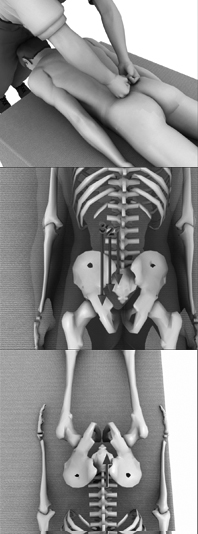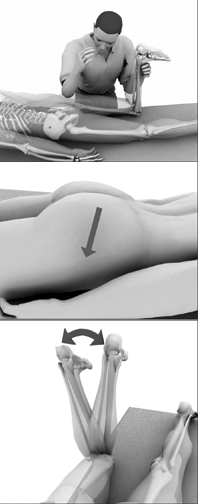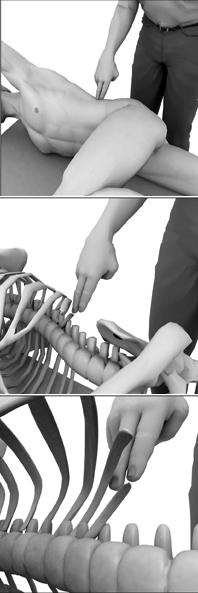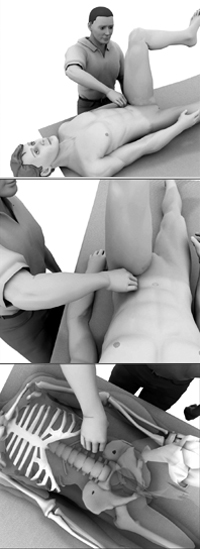
Features
Practice
Technique
Treating Pain With Myofascial Techniques
It had been over 16 years since I was on the Toronto TTC taking my last train from Kikkawa College (now called ICT) to my home in Thornhill, Ontario. As I dozed off on the subway car, it arrived at one of its stations. I said to myself ‘oh here we are at Sheppard.’ What was interesting was that I recognized the station not by the signage but by how the car moved on the tracks.
October 1, 2009 By Barry Jenings RMT
It had been over 16 years since I was on the Toronto TTC taking my last train from Kikkawa College (now called ICT) to my home in Thornhill, Ontario. As I dozed off on the subway car, it arrived at one of its stations. I said to myself ‘oh here we are at Sheppard.’ What was interesting was that I recognized the station not by the signage but by how the car moved on the tracks. I felt those familiar turns and twists and remembered it somatically, or in my body first.
What I found interesting is that after all those years I could still remember, and the memory was strong. Fascia has that same ability. And, Myofascial Release and its advanced form, called Structural Integration, has the technical ability to connect with this memory state, both mechanically and somatically.
Trauma to the fascia, whether it be physical or psychological, can imprint or distort both the superficial and deep layers of the fascia.
Chronic distortions are believed to be held at the molecular structure of the fascial web and this trauma can be years, even decades-old.
In fact, the trauma may stay at the sub clinical level and then seemingly “just happen.” It has no frame of time, quite similar to the theory presented by the movie “What the Bleep do we know” which looks at reality in quantum physics.
Now picture a water bottle. Maybe the one right beside you. If you took that, empty water bottle and squeezed it really hard it would crumple. In some cases the crumple would stay in that shape. Trauma to the fascia (body) can have a similar effect. The fascia can distort and get stuck. Researchers say it is both a energy block and resulting in a mechanical increase in disorganized collagen.
About Fascia:
I have had the pleasure of meeting and researching such incredible teachers such as Michael Shea, George Roth, Tom Myers, James Oshman and reading works of Dr. Ida Roth. What was similar to all those individuals was their incredible fascination with the fascial structure and substructures. And, while writing this article, I was
heading to Philadelphia to continue my studies in osteopathic modalities to find out more, to hear another idea … to simply learn. The molecular structure of fascia was best illustrated by Buckminster Fuller, a brilliant architect who applied simple but incredible strong natural occurring geometrical units to engineering.
Go to www.bfi.org to learn more.
- Now, back to your traumatized water bottle, a.k.a. fascia. After a trauma, the fascia gets laid down in a thickened shortened nature.
The tissue, and, in fact the whole body, can undergo a significant change in functional, physiologically, and energenitically seemingly far from chief complaint. In the SI model, we use MFR to balance align or straighten the entire body. Instead of treating the so-called site of pain we treat the whole body. Perhaps a more humble way of saying this is that we have no idea where the real problem is but we are pretty sure we will find it after 10 sessions of SI. And, fortunately for us, we usually do.
Myofascial Release (MFR) works because as Dr. Karel Lewit, Professor, Rehabilitation Clinic, Czech Republic,
stated: “He who treats the site of pain is lost.” And, Ida Rolf, the brilliant biochemist turned body worker agrees: “If you think you know where it is it isn’t.” And I to my friends have been humbled many times by this elusive structure called fascia.
Treating in 3D:
Heeding this legendary advice, and re-inforced by my constant clinical failures early in my practice, I began to study and treat this complex tissue that can mold and distort the muscle and bones unconditionally.
With over 2,000 pounds of tensile strength, I later learn there would no overpowering this structure called
fascia. What was required was a new approach; again the road led me to MFR and its theory of treating the structure fully. Concisely, it requires the therapist to treat the front, back and each side of the site of pain. Eventually, it leads us to treat the whole using MFR.
In trying to restore our poor water bottle we have to un-collapse it, step by step, gently helping it to regain its normal healthy tensegretity shape.
Go slow, and the body via the fascia will respond dramatically.
• On the following pages, we take a look at a series of lumbar releases using Myofascial Release. The information is taken from my manual on Myofascial Release Techniques.

|
SACRAL-ILIAC: PRONE
Purpose:
Use this technique to improve mobility of the general sacral-iliac (SI) joint. This release allows the pelvis to move more freely and independently.
Positioning:
Your client will be lying prone.
Technique:
- With both knuckles, glide over the sacrum. As you are doing this, have the client do an anterior pelvic tilt, thereby moving the tissue through your hands. Continue to glide over the sacrum. Repeat three times.
- With your elbow, glide down between the sacral iliac borders gently. Repeat three times.

|
PIRIFORMIS: PRONE
Purpose:
A specific technique for piriformis syndrome, this release helps decrease excessive internal rotation, which results in hip and joint dysfunction.
Positioning:
Your client will be lying prone.
Technique:
At the attachment to the sacrum, use your elbow to glide down the muscle to its attachment to the femur. Repeat this technique three times.

|
FLOATING 12TH RIB: SIDE-LYING
Purpose:
Releasing the 12th rib helps to reposition and give mobility to this bony landmark.
Positioning:
Your client is lying on their side.
Technique:
In some cases, this rib can be pulled down into the ilium. To find this structure, the whole area must be relaxed and supple.
It is often easier to locate the 12th rib by first moving off the rim of the ilium and slowly proceeding down into the superior attachments of the QL.
Once you have located the 12th rib, using one or two fingers, glide along the bone in very small gentle strokes. The technique is a small cleaning off of the bone.
Do not press straight down on the rib, as if you are pressing it into the body or trying to bend or flex it. Repeat on the other side.
Movement:
Have the patient gently reach with their arm or breathe into the area you are working.

|
PSOAS: SUPPINE
Purpose:
The psoas is considered the deepest or core fascial structure; it is probably the most important myofascial tissue. Fascial restrictions here can lead to a number of effects including pain in the lumbar, pelvic, sacral and groin areas. Its proper function, strength and flexibility are paramount to the overall health of the individual.
Positioning:
Your client will be lying suppine.
Technique Options:
- Locate the psoas by moving slightly superior and medial off the ASIS. Avoid the femoral triangle. With their knees flexed, have the patient pull their knee up while you resist them. This will cause the psoas to contract into your fingers. If it does not, then move either medially or laterally and try again.
- Once you have located the psoas, have the client relax their leg as you support it. Gently sink into the psoas further and hold this position.
- Next, have your client slowly lower their leg to the table, thereby straightening out their leg, pushing their heel out and toes up. As they are doing this, hold onto the psoas. This area may be very tender, so stay in communication.
- Repeat three times, moving slightly superiorly up and along the muscle (one or two inches) and release the further fibres of the psoas.
Movement:
While the client is lowering their leg, have them reach with either arm over their head, keeping their hand open and fingers pointed.
Print this page